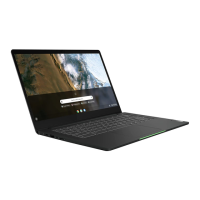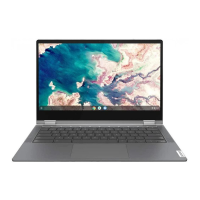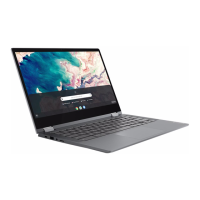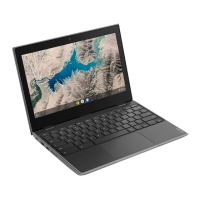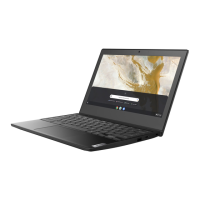Do you have a question about the Lenovo 500e Chromebook and is the answer not in the manual?
Information to help safely use the personal computer and retain all included information.
Describes conditions like odor, smoke, or sparks that may indicate a potential safety issue requiring immediate attention.
Guidance on not attempting self-service and using approved service providers for repairs.
Safety precautions for using power cords and adapters to prevent hazards and damage.
Safety guidelines for using electrical outlets and plugs with the computer to prevent damage.
Warning regarding internal components of the power supply unit and hazardous voltage.
Safety measures to avoid electric shock when connecting/disconnecting cables and during storms.
Warnings about coin-cell, built-in, and removable batteries, including explosion risks.
Precautions to prevent overheating and ensure proper ventilation for the computer's operation.
Caution regarding the glass nature of the LCD and handling mercury in fluorescent lamps.
Guidelines for selecting and using extension cords, surge protectors, and power strips.
Warnings about hearing loss from high volume and compliance with EN 50332 standards.
Warning about suffocation hazard from plastic bags for children and infants.
Caution about potential breakage of glass parts and not touching broken glass.
Guidelines for supervising children using the Chromebook, emphasizing safe handling.
Warnings about choking hazards, electrical safety, and proper handling for children.
Overview of front panel components like display, keyboard, touchpad, webcam, and microphone.
Identifies and describes ports on the left and right sides, including USB, Type-C, audio, and microSD.
Information on power button, volume buttons, power light, and webcam light status.
Lists general hardware specifications like dimensions, display, memory, storage, battery, and adapter.
Details on maximum altitude, temperature, and humidity limits for operation and storage.
Explains the three types of user accounts: Google, Guest, and Supervised, for logging into Chrome.
Steps to set up the Chromebook for the first time and establish the device owner.
Instructions for adding another Google Account to sign in and use the Chromebook.
How to use a temporary guest account for sharing the Chromebook without logging in.
Steps to create a supervised account for child usage and parental control over internet use.
How to temporarily lock the Chromebook to protect settings and files from unauthorized access.
Instructions on how to sign out of the current login session to switch users.
Steps for the owner to restrict sign-in to specific Google Accounts for security.
Procedure to identify who the owner of the Chromebook is by checking settings.
How the owner can disable guest browsing for enhanced security and control.
Steps to reset the Chromebook to factory settings, including advice on data backup.
Instructions on how to properly shut down the Chromebook to save power.
Information on accessing the Get Help app and Google's online community for Chromebook support.
Explanation of Google Drive as a server-based file storage and sharing service.
Describes local storage, typically in the Downloads folder, assigned to each Google Account.
Introduction to the Files app for managing files on local storage, external devices, or Google Drive.
Steps to create folders and sub-folders within the Files app for better file organization.
Instructions for deleting unnecessary files to free up storage space on the device.
How to check the available storage space on your Chromebook to manage files.
Steps to change the operating system's display language on your Chromebook.
How to add new input methods for typing text in different languages.
Instructions for switching between multiple input methods for typing.
Explanation of the Chrome Web Store as a resource for apps and extensions.
Steps to find and add apps or extensions from the Chrome Web Store.
Guidance on downloading and installing Android apps from the Google Play Store.
How to pin frequently used apps to the shelf for quick access from the desktop.
Instructions for pinning frequently visited web pages to the shelf for easy access.
Importance of ergonomic practices for comfort and maximizing computer performance.
Tips for adapting your workspace and habits for better performance and comfort.
General tips for maintaining the computer, avoiding magnets, extreme temperatures, and proper handling.
Guidance on periodic cleaning of the computer cover, keyboard, and screen for upkeep.
Links to Lenovo compliance sites and general recycling information for IT products.
Information on RoHS, FCC, German, EU, and Japan VCCI compliance requirements.
Details on ENERGY STAR qualification and Brazil audio caution statements.
Link to Lenovo's website for technical support information and resources.
Guidance on contacting Lenovo customer support for telephone assistance during the warranty period.
Information to have ready before contacting customer support for efficient troubleshooting.
Lists services provided by support, such as problem determination and hardware repair.
Lists services not provided, like third-party parts support or software troubleshooting.
Link to find Lenovo support phone numbers for your specific country or region.
Covers warranty scope, how to get service, customer responsibilities, service provider actions, exclusions, liability limits, and general rights.
Details warranty terms and dispute resolution for various countries and regions.
Explains types of warranty service, including CRU, on-site, mail-in, and exchange services.
Lists trademarks and registered trademarks for Lenovo, Google, and other entities.
| Internal memory | 8 GB |
|---|---|
| Memory clock speed | 2400 MHz |
| Memory form factor | On-board |
| Internal memory type | LPDDR4-SDRAM |
| Storage media | eMMC |
| Optical drive type | No |
| Card reader integrated | Yes |
| Total storage capacity | 64 GB |
| Compatible memory cards | MicroSD (TransFlash) |
| Number of HDDs installed | 0 |
| Form factor | Convertible (Folder) |
| Product type | Chromebook |
| Product color | Black |
| Housing material | Acrylonitrile butadiene styrene (ABS) |
| Display diagonal | 11.6 \ |
| Touch technology | Multi-touch |
| Touchscreen type | Capacitive |
| Display brightness | 250 cd/m² |
| Display resolution | 1366 x 768 pixels |
| Native aspect ratio | 16:9 |
| Tjunction | 105 °C |
| Processor cache | 4 MB |
| Processor cores | 4 |
| Processor model | N4100 |
| System bus rate | - GT/s |
| Processor family | Intel® Celeron® |
| Processor socket | BGA 1090 |
| Processor codename | Gemini Lake |
| Processor frequency | 1.1 GHz |
| Processor lithography | 14 nm |
| Processor manufacturer | Intel |
| PCI Express slots version | 2.0 |
| Processor boost frequency | 2.4 GHz |
| Processor operating modes | 64-bit |
| PCI Express configurations | 1x2, 1x2+2x1, 1x4, 2x1, 4x1 |
| Thermal Design Power (TDP) | 6 W |
| Scenario Design Power (SDP) | 4.8 W |
| Maximum number of PCI Express lanes | 6 |
| Number of execution units | 12 |
| On-board graphics card ID | 0x3185 |
| On-board graphics card model | Intel® UHD Graphics 600 |
| On-board graphics card family | Intel® UHD Graphics |
| On-board graphics card base frequency | 200 MHz |
| On-board graphics card DirectX version | 12.0 |
| On-board graphics card dynamic frequency (max) | 700 MHz |
| Speaker power | 2 W |
| Number of built-in speakers | 2 |
| Front camera signal format | 720p |
| Rear camera resolution (numeric) | 5 MP |
| Antenna type | 2x2 |
| Wi-Fi standards | 802.11a, 802.11b, 802.11g, Wi-Fi 4 (802.11n), Wi-Fi 5 (802.11ac) |
| Bluetooth version | 4.2 |
| Top Wi-Fi standard | Wi-Fi 5 (802.11ac) |
| USB 2.0 ports quantity | USB 2.0 ports have a data transmission speed of 480 Mbps, and are backwards compatible with USB 1.1 ports. You can connect all kinds of peripheral devices to them. |
| Pointing device | Touchpad |
| Operating system installed | ChromeOS |
| Sustainability certificates | RoHS, EPEAT Silver |
| AC adapter power | 45 W |
| Battery life (max) | 10 h |
| Processor ARK ID | 128983 |
| Processor package size | 25 x 24 mm |
| CPU configuration (max) | 1 |
| Intel Smart Response Technology version | 0.00 |
| Intel Identity Protection Technology version | 1.00 |
| Depth | 204 mm |
|---|---|
| Width | 290 mm |
| Height | 20.35 mm |
| Weight | 1300 g |


